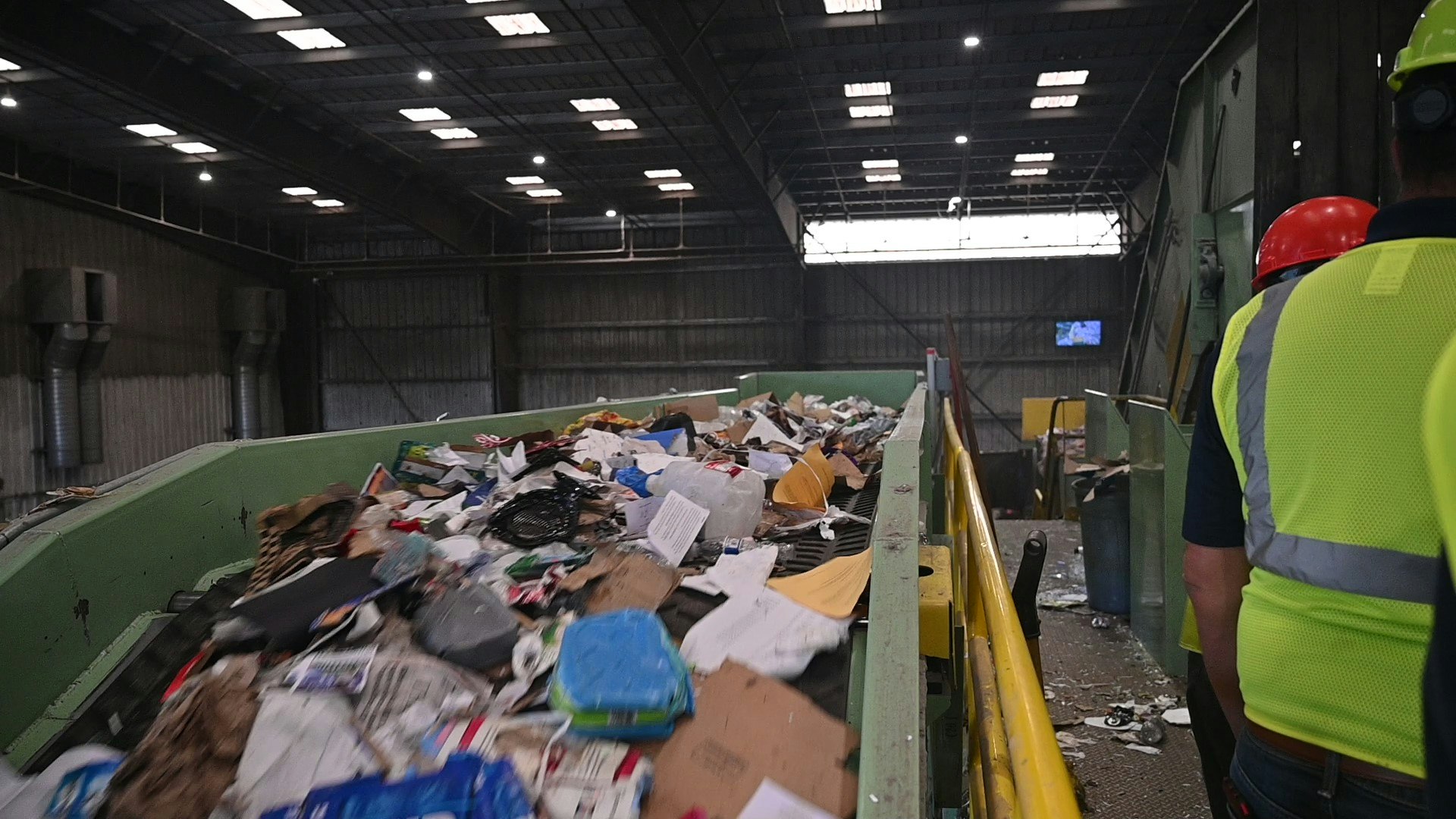Let's Talk About Recycling
You've probably heard a lot of theories about recycling. That it all gets thrown in the landfill, or sent abroad, or that it's just a waste of time. And we get it. Throwing a whole bunch of materials in the same bin and expecting them to turn into something new seems pretty far-fetched. So how do your papers, plastics, metals and glass go from the bin at your curb to new products?
The Journey of Recycling
When you put items in your blue recycling bin, they're picked up by your garbage company and hauled to the Materials Recovery Facility (MRF, pronounced "murf", for short). In SLO County, our recycling ends up at Cold Canyon MRF, located just outside the city of San Luis Obispo. It's a big, warehouse-like building, with millions of dollars of technology inside. All of the following images were taken at the Cold Canyon MRF.
Trucks come in one after another to dump loads of recycling at the MRF. Upon arrival the trucks pass over a scale, that weighs the load they collected. They dump into a big pile on the tipping floor, where employees in specialized equipment load it onto the sorting line.

The sorting line is a high-tech series of conveyor belts, machinery and robots that sort the materials. First, trained employees pick out major contaminants by hand: plastic bags, bulky objects, styrofoam, and anything that will create problems later along the way.
The sorting line has a variety of methods to sort materials by size, shape or material type.
Screens are used to sort out contaminants that are too small to be recycled. A series of vertical disks rotate quickly, forcing large, flat materials like cardboard to float to the top while small pieces fall to the bottom. Glass screens use a similar principle: glass bottles and jars are crushed by a machine, and go over a screen. The small pieces of glass fall to the bottom while materials like plastic caps, metal lids and paper labels are sorted out at the top.
Employees hand sort the paper into different grades and remove contaminants like plastic bags and film plastic.
Putting the wrong things in the wrong bins, aka "contamination", is the number one cause of materials not getting recycled.
Robotic Sorters use artificial intelligence to identify the materials that pass by on the conveyor belt. They classify each item and use a robotic arm to pick out materials by type, like hard plastic jugs.
A large magnetic belt pulls the ferrous metal cans from the sorting line.
An eddy current separator uses magnets to remove nonferrous metals like aluminum. Powerful magnets rotate under the conveyor belt at high speeds. Aluminum is not magnetic, but passing over those magnets generates a magnetic field around each piece of aluminum. This repels the aluminum from the magnet, as it's shot out into a separate bin.

Each of these materials are baled after they're sorted. A baler is a large machine that compacts materials before they're sold. The bales are wrapped with thick metal wires that help each cube keep its shape. The bales are what's sold to markets that purchase our recyclables and turn them into new products.

It's Important to Remember When Recycling...
Materials are not cleaned along the sort line. The material you throw into the blue bin is sorted by the facility but never cleaned. This is why it's important to clean things at home before you recycle them: the dirtier the finished bales of materials are, the less valuable they are and the more likely they are to be thrown away or downcycled. Downcycling is turning materials into a lower-quality, typically unrecyclable product. For example, a high-quality bale of plastic can be made into new plastic bottles, but downcycled plastic might turn into a fleece or a plastic bench. Both recycling and downcycling are important for keeping materials out of our landfills, but only true 'closed-loop' recycling ensures that materials stay in circulation.
Landfill material is not sorted at the facility. That's why it's important to use your blue bin for recycling and your green bin for organics - recycling relies on you. When garbage trucks dump our garbage at the landfill, it goes directly into the ground. So when you throw an item in the gray garbage bin, that item is going to spend the rest of its life in the landfill. It's too messy and cumbersome of a process to go through the garbage stream to pull out anything of value. Material that goes into the garbage will never have the opportunity to be made into something new.
Recycling is a flawed system.
Recycling is an important part of how we use our materials sustainably. Many of the things we use in daily life are not designed for reuse, so recycling is the solution for creating a new life for them. It reduces the amount of natural resources we consume, and reduces the amount of material that we bury in the ground at the landfill.
Recycling makes a difference, but it is not the whole solution.
Many products are made in a way that they can't be recycled, so we have to landfill them. Many things are downcycled, which limits the life of that product when it can only be remade once. It's important to always reduce and reuse first. Recycling a plastic bottle ensures it can have another life, but the far better solution is to have never created that plastic bottle in the first place.
